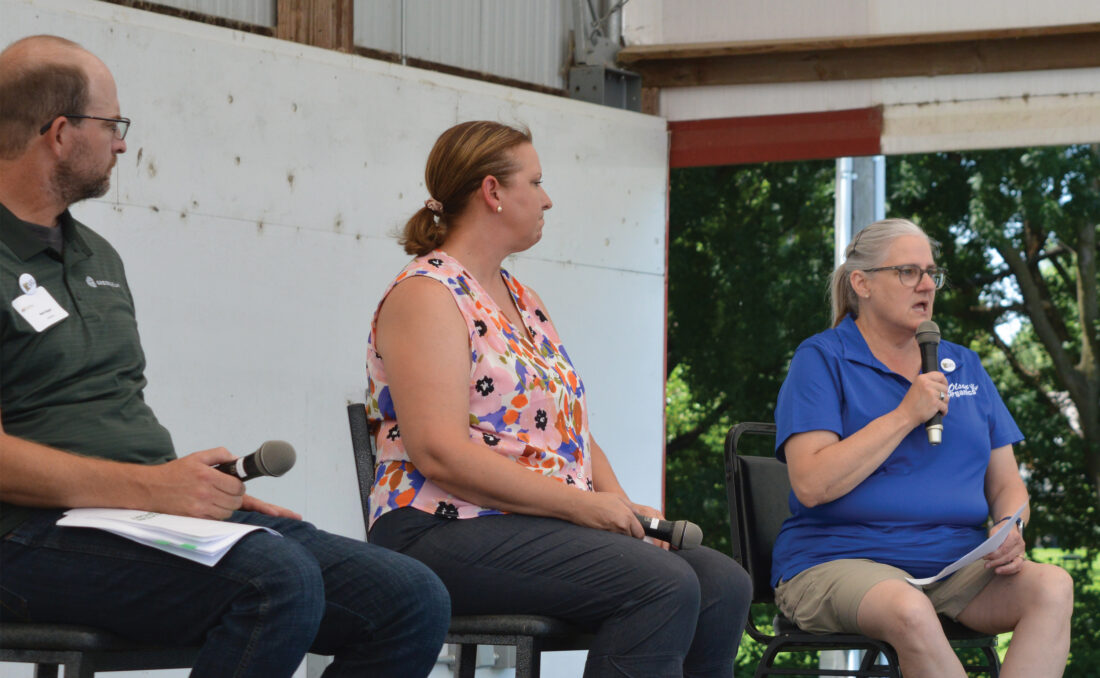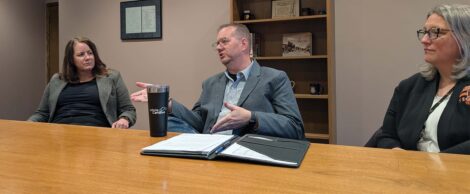Lower grain prices, input costs ‘hitting farmers pretty tough’
State of Ag panelists share rural challenges, trends

Photo by Deb Gau Moderator Carolyn Olson, at far right, introduces panelists Julie Tesche and Sam Ziegler during the 2025 State of Agriculture event in Marshall.
MARSHALL — Some of the big challenges facing farmers in southwest Minnesota aren’t really new, but they have a big impact, speakers at a Tuesday agriculture panel said.
In a study of more than 1,500 Minnesota farms, the median net income dropped 80% between 2021 and 2024, Chase VanKeulen said.
“That’s due to a lot of different factors. But mainly, grain prices have been coming down and inputs really have not followed,” VanKeulen said. “They’re staying at the same levels or they’re even increasing, and it’s really just hitting farms pretty tough.”
While speakers at the 2025 State of Agriculture panel at the Lyon County fairgrounds did discuss topics like farm challenges and declining birth rates in rural communities, they also talked about how to try and encourage growth.
State of Ag panelists included Julie Tesche, of the Center for Rural Policy & Development, Sam Ziegler of the food and agriculture development organization GreenSeam, and VanKeulen, a farm business management instructor at Minnesota West Community & Technical College.
Moderator Carolyn Olson said all three of the organizations represented on the panel had released annual reports on issues related to agriculture and rural populations. During the discussion, she and panelists dug into some of their findings.
“I’d like you to talk about one or two trends or data points that were surprising, or that you feel is important for this group to hear,” Olson said.
“A lot of the research that we look at, it’s not surprising, but we’re able to put the numbers behind it,” Tesche said.
For example, she said, it wasn’t a surprise for people in rural communities to learn they are having more deaths than births, as baby boomers age. But it was an important factor for rural communities.
“That is one thing that we’ve really been trying to tell people,” she said. “We are not able, in rural (areas), to sustain our population. So what are we going to do to attract people to our communities?”
“As a farm business management instructor, we’re really working with farmers across the state. We help them with their financial records or accounting records, and we do a whole farm analysis on all the farms that we work with,” VanKeulen said.
Based on that data, he said, “In 2021, the median net farm income was $176,000. In 2024, the median net farm income is down to $12,000.”
With factors like falling grain prices and increasing input costs, he said, “As of right now here’s not really any light at the end of the tunnel.”
VanKeulen said one of the things that made a difference for profitability in the farms surveyed was knowing their production costs.
“The bigger picture is you have to know your numbers. If you don’t know what it costs to produce a bushel of corn, you don’t know what you need to market it for,” he said.
VanKeulen said farms have a “huge” impact on Minnesota’s economy.
“Out of the 1,500 farms that we surveyed, the average farmer spent $1.2 million in their local economy this year,” he said. “So take that over a 40-year farming career, every farmer is going to put roughly $50 million back into their local economy. And that’s just the direct dollars that they’re spending on inputs, machinery, whatever it may be.”
That figure didn’t include things like jobs supported by agriculture, VanKeulen said.
Ziegler said GreenSeam’s research for its annual State of Agriculture reports focused on topics like the challenges and impacts to the agriculture and food production industries in Minnesota.
“We try to get a pulse on the economy,” he said.
Among the businesses GreenSeam surveyed, input costs and hiring were among the top concerns, Ziegler said.
“It gets down to, are there folks available to do the jobs that we need done? Because automation and AI and all those things don’t replace at the same level,” he said.
The need to hire workers also tied into other community needs like access to housing and child care.
Ziegler said other factors might also be holding businesses back from growth. Over the past year, economic uncertainties had many businesspeople holding back on making decisions on new projects or expansions.
“It feels like we’re still in that little bit of holding pattern that people are doing well overall, but not sure if they should make that extra decision,” Ziegler said.
Tesche spoke on patterns of migration in southwest Minnesota. Based on data of students in the region in the 10 years after high school, she said, “If students leave a rural area, if they leave Marshall, odds are they’re not going to come back.”
But not all young people leave southwest Minnesota, Tesche said.
“The interesting thing, and the good highlights are, is students who took career and technical education credits — so, welding, shop, agriculture, FACS — those students were more likely to either stay, or if they did go somewhere else, they’re more likely to come back.”
Students attending community and technical colleges also tended to stay in the region, she said.
“One quick other thing I’ll say is, towns like Marshall are doing well,” Tesche said. “Regional centers are doing well. People are moving more to regional centers or the adjacent areas.”
Tesche and Ziegler said factors like having strong marketing to attract new residents, and finding ways to encourage young people to come back, have been positive for some rural Minnesota communities.

